ESP CITROEN DS3 CABRIO 2014 Handbook (in English)
[x] Cancel search | Manufacturer: CITROEN, Model Year: 2014, Model line: DS3 CABRIO, Model: CITROEN DS3 CABRIO 2014Pages: 384, PDF Size: 11.85 MB
Page 163 of 384
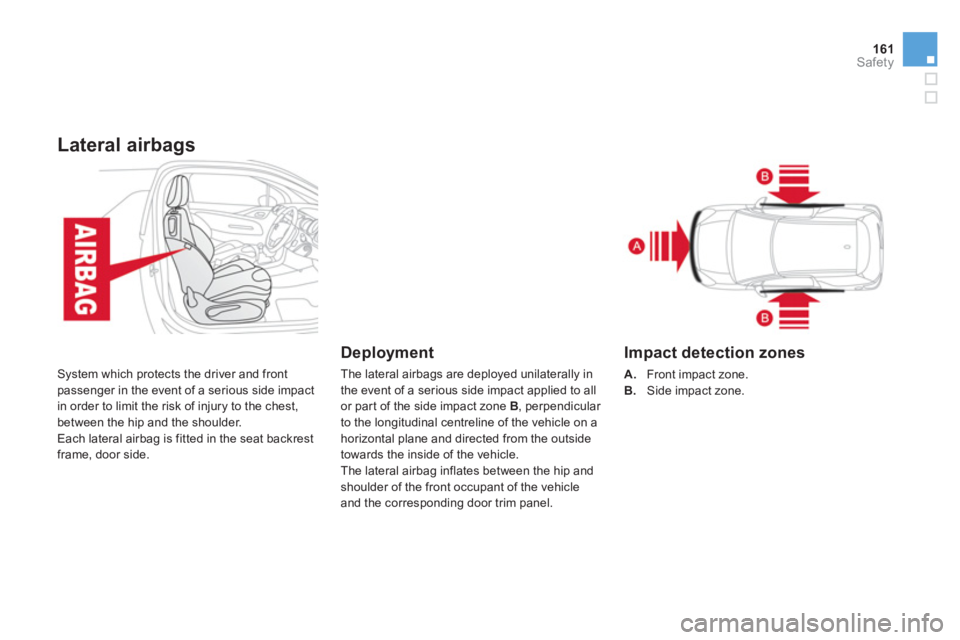
161Safety
Lateral airbags
System which protects the driver and frontpassenger in the event of a serious side impact
in order to limit the risk of injury to the chest,
between the hip and the shoulder.
Each lateral airba
g is fitted in the seat backrestframe, door side.
Deployment
Impact detection zones
A.Front impact zone.
B. Side impact zone.
The lateral airba
gs are deployed unilaterally in
the event of a serious side impact applied to all
or par t of the side impact zone
B, perpendicular
to the longitudinal centreline of the vehicle on ahorizontal plane and directed from the outside
towards the inside of the vehicle.
The lateral airbag inflates between the hip and
shoulder of the front occupant of the vehicle and the corresponding door trim panel.
Page 164 of 384
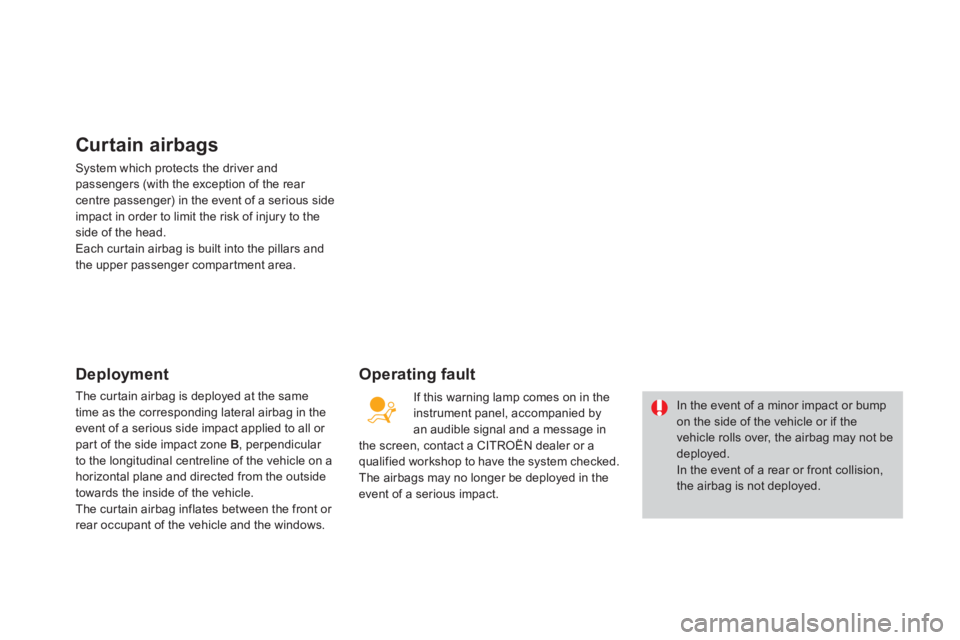
Curtain airbags
System which protects the driver and passengers (with the exception of the rear centre passenger) in the event of a serious side
impact in order to limit the risk of injury to the side of the head.
Each curtain airbag is built into the pillars and
the upper passenger compartment area.
Deployment
The cur tain airbag is deployed at the same
time as the corresponding lateral airbag in the event of a serious side impact applied to all or par t of the side impact zone B, perpendicular
to the longitudinal centreline of the vehicle on a horizontal plane and directed from the outside
towards the inside of the vehicle.
The cur tain airbag inflates between the front or rear occupant of the vehicle and the windows.
Operating fault
In the event of a minor impact or bump on the side of the vehicle or if the vehicle rolls over, the airbag may not be deployed.
In the event of a rear or front collision, the airbag is not deployed. I
f this warning lamp comes on in theinstrument panel, accompanied by
an audible signal and a message in
the screen, contact a CITROËN dealer or a
qualified workshop to have the system checked.The airbags may no longer be deployed in theevent of a serious impact.
Page 176 of 384

When you move the lever in the gate to selecta position, the corresponding indicator isdisplayed in the instrument panel.P. Park R.ReverseN.
Neutral D.
Drive (Automatic driving) S.Sportprogramme�7.Snowprogramme 1 2 3 4. Gears engaged during manualoperation -.Invalid value during manual operation
Displays in the instrument panel
Foot on brake
�)
Press the brake pedal when this
indicator lamp is displayed in the
instrument panel (e.g.: star tingthe engine).
Moving off
If position Nis selected inadvertently while driving, allow the engine to return to idle then select position D
to accelerate.
When the engine is running at idle, with the brakes released, if position R , D
or
M
is selected, the vehicle moves evenwithout the accelerator being pressed. When the engine is running, never leave children in the vehicle without supervision.
When carrying out maintenance with the engine running, apply the parkingbrake and select position P
.
P
�)
Apply the parking brake.�)
Select position P
or N.�)
Start the engine.
If this procedure is not followed, there is an
audible signal, accompanied by the display of
an warning message.
�) With the engine running, press the brake
pedal.
�) Release the parking brake.�)
Select position R , D
or M . �)
Gradually release the brake pedal.
The vehicle moves off immediately.
Page 179 of 384
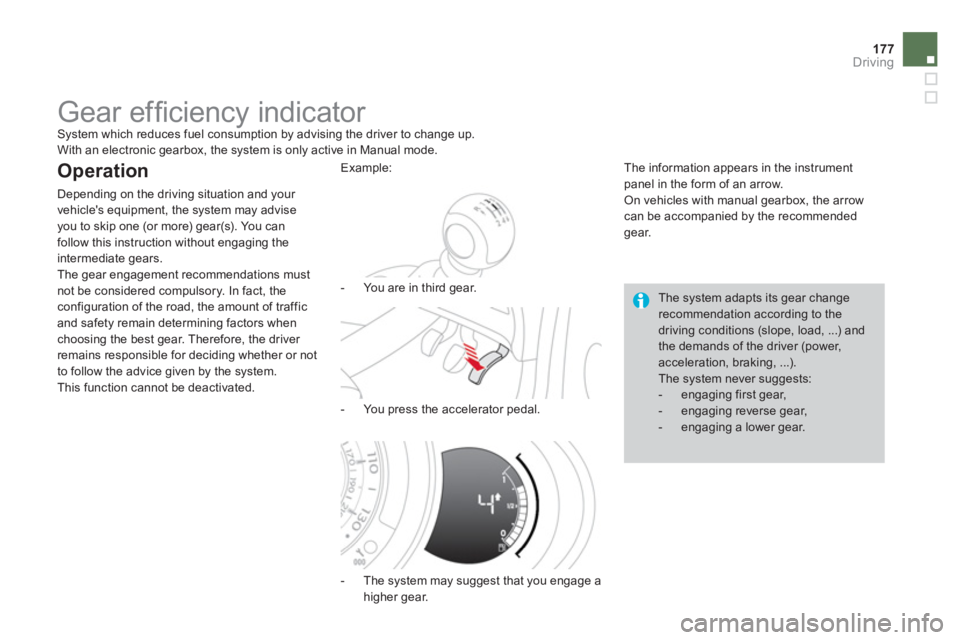
177Driving
Gear effi ciency indicator System which reduces fuel consumption by advising the driver to change up.
With an electronic gearbox, the system is only active in Manual mode.
Operation
Depending on the driving situation and your
vehicle's equipment, the system may advise
you to skip one
(or more) gear(s). You can follow this instruction without engaging the
intermediate gears.
The gear engagement recommendations mustnot be considered compulsory. In fact, the configuration of the road, the amount of traffic
and safety remain determining factors whenchoosing the best gear. Therefore, the driver
remains responsible for deciding whether or not
to follow the advice given by the system.
This function cannot be deactivated.
- The s
ystem may suggest that you engage a
higher gear.
The in
formation appears in the instrument panel in the form of an arrow.
On vehicles with manual gearbox, the arrow can be accompanied by the recommendedgear.
The system adapts its gear change recommendation according to thedriving conditions (slope, load, ...) and the demands of the driver (power,acceleration, braking, ...). The system never suggests:
- engaging first gear,
- engaging reverse gear,
- engaging a lower gear.
Example:
- You are in third
gear.
- You press the accelerator pedal.
Page 184 of 384
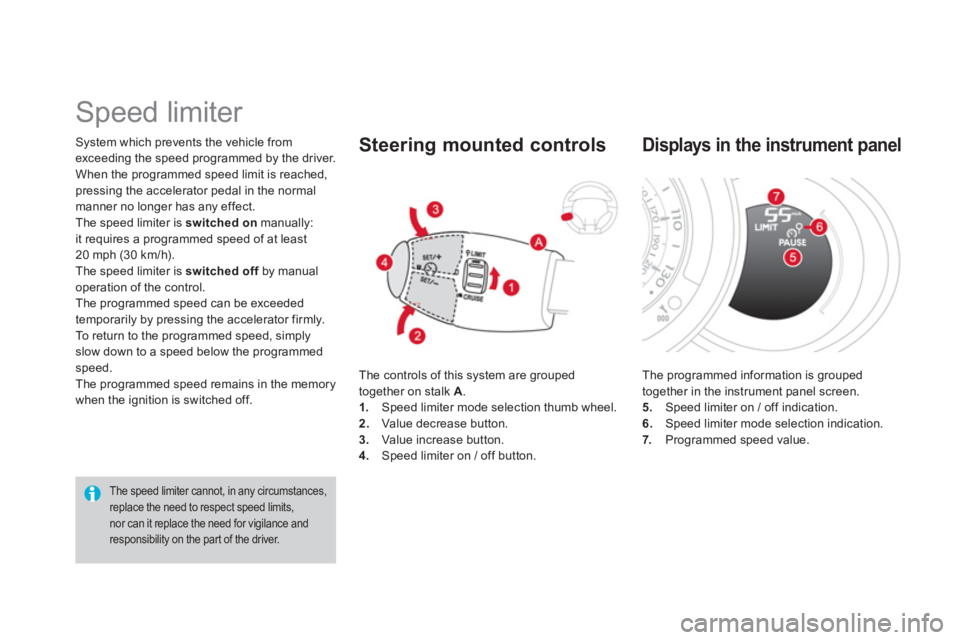
System which prevents the vehicle fromexceeding the speed programmed by the driver.
When the programmed speed limit is reached, pressing the accelerator pedal in the normalmanner no longer has any effect.
The speed limiter is switched onmanually:
it requires a programmed speed of at least
20 mph (30 km/h). The speed limiter is switched off by manual foperation of the control.
The programmed speed can be exceeded
temporaril
y by pressing the accelerator firmly.
To return to the programmed speed, simply slow down to a speed below the programmed speed.
The programmed speed remains in the memorywhen the ignition is switched off.
Speed limiter
The speed limiter cannot, in any circumstances, replace the need to respect speed limits, nor can it replace the need for vigilance and responsibility on the par t of the driver.
The controls of this system are grouped
together on stalk A
.
1
.Speed limiter mode selection thumb wheel.
2. Value decrease button. 3.
Value increase button. 4.Speed limiter on / off button.
Steering mounted controls
The programmed information is grouped
together in the instrument panel screen.
5
. Speed limiter on / off indication.
6. Speed limiter mode selection indication.
7. Programmed speed value.
Displays in the instrument panel
Page 186 of 384
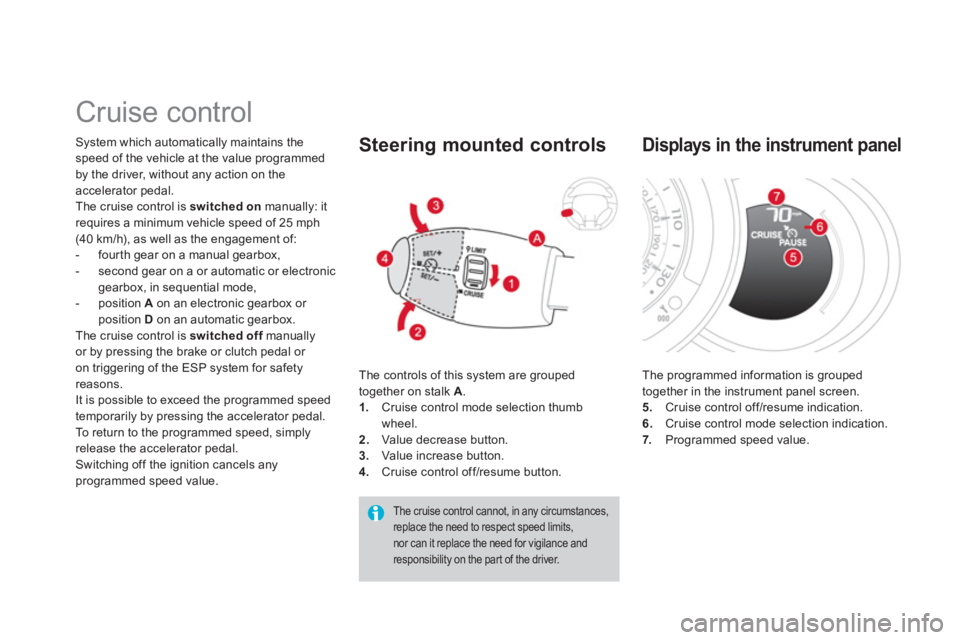
Cruise control
System which automatically maintains the
speed of the vehicle at the value programmed
by the driver, without any action on the accelerator pedal.
The cruise control is switched on
manually: itrequires a minimum vehicle speed of 25 mph
(40 km/h), as well as the engagement of:
- fourth gear on a manual gearbox,
- second gear on a or automatic or electronic
gearbox, in sequential mode,
-
position A
on an electronic gearbox or position D
on an automatic gearbox.
The cruise control is switched offmanuallyfor by pressing the brake or clutch pedal or
on triggering of the ESP system for safety reasons. It is possible to exceed the programmed speed
temporarily by pressing the accelerator pedal.
To return to the programmed speed, simply
release the accelerator pedal.
Switching off the ignition cancels any programmed speed value. The controls o
f this system are grouped
together on stalk A
.
1.Cruise control mode selection thumb
wheel.
2. Value decrease button. 3.
Value increase button. 4.Cruise control off/resume button.
Steering mounted controls
The cruise control cannot, in any circumstances, replace the need to respect speed limits, nor can it replace the need for vigilance and responsibility on the par t of the driver.
The programmed information is grouped
together in the instrument panel screen.
5. Cruise control off/resume indication.
6. Cruise control mode selection indication.
7. Programmed speed value.
Displays in the instrument panel
Page 188 of 384

Rear parking sensors
System consisting of four proximity sensors,
located in the rear bumper.
This detects an
y obstacle (person, vehicle,
tree, gate, etc.) behind the vehicle, except
obstacles located just below the bumper.
An object, such as a stake, a roadworks cone or any other similar object may
be detected at the beginning of themanoeuvre, but may no longer be detectedwhen the vehicle comes close to it.
The parking sensor system cannot, in any circumstances, take the place of the vigilance and responsibility of the driver. The system is activated as soon as reverse
gear is engaged, accompanied by an audible
signal. The proximity information is given by:
- an audible signal, which becomes more
rapid as the vehicle approaches the
obstacle.
- a graphic (according to version) in the
multifunction screen, with blocks whichbecome increasingly closer to the vehicle.
Activation
When the distance between the rear of the vehicleand the obstacle is less than thir ty centimetres, the
audible si
gnal becomes continuous and the "Danger"symbol appears in the multifunction screen.
On completion of the manoeuvre, when you exit
reverse gear, the system becomes inactive.
Page 197 of 384

195
Checks
Checking levels
Check all of these levels regularly, in line with the maintenance and warranty guide. Top them up if necessary, unless other wise indicated.
If a level drops si
gnificantly, have the corresponding system checked by a CITROËN dealer or a qualified workshop.
Oil level
Engine oil change
Refer to the maintenance and warranty guide
for details of the interval for this operation.
In order to maintain the reliabilit
y of the engine and emission control system, the use of additives in the engine oil is prohibited.
Oil specifi cation
The oil must be the correct grade for your
en
gine and conform to the manufacturer'srecommendations.
Brake fluid level
Changing the fl uid
Refer to the maintenance and warranty guidefor details of the inter val for this operation.
Fluid specifi cation
The brake fluid must conform to themanufacturer's recommendations and meet
the DOT4 l o w v i s c o s i ty / ISO 4925 Class6 standard. Th
e brake fluid level should be close
to the "MA X" mark. If it is not, check
the brake pad wear.The check is carried out either when
the ignition is switched on using the
oil level indicator in the instrumentpanel, or using the dipstick.
It is normal to top up the oil levelbetween two ser vices (or oil changes).CITROËN recommends that you check the level, and top up if necessary, every3 000 miles (5 000 kms). After topping up the oil, the check when switching on the ignition with the oil level indicator in the instrument panel is not valid during the 30 minutes after topping up.
Take care when working under the bonnet, as certain areas of the engine may be extremely hot (risk of burns) and the cooling fan could star t atany time (even with the ignition off).
It will onl
y be correct if the vehicle is on level ground and the engine has been off for more
than 30 minutes.
Page 223 of 384
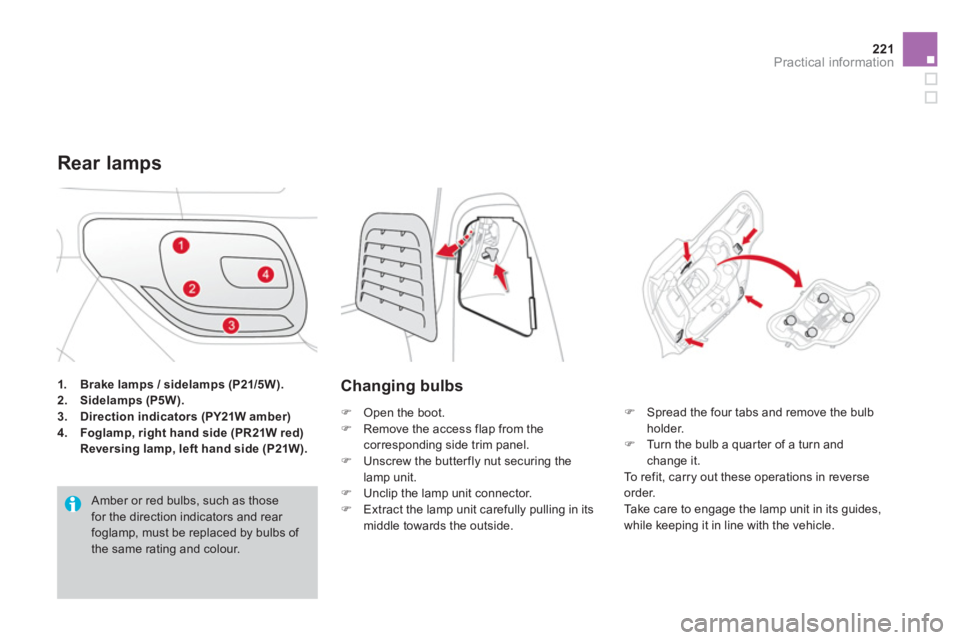
221Practical information
1.Brake lamps / sidelamps (P21/5W).2.Sidelamps (P5W).3.Direction indicators (PY21W amber)4.Foglamp, right hand side (PR21W red)Reversing lamp, left hand side (P21W).
Rear lamps
Amber or red bulbs, such as thosefor the direction indicators and rear foglamp, must be replaced by bulbs of the same rating and colour.
Changing bulbs
�) Open the boot. �)
Remove the access flap from the corresponding side trim panel.�)
Unscrew the butterfly nut securing thelamp unit.�)
Unclip the lamp unit connector.�)
Extract the lamp unit carefully pulling in its
middle towards the outside.
�) Spread the four tabs and remove the bulbholder. �)
Turn the bulb a quar ter of a turn andchange it.
To r efit, carry out these operations in reverseorder.
Take care to engage the lamp unit in its guides,
while keeping it in line with the vehicle.
Page 224 of 384
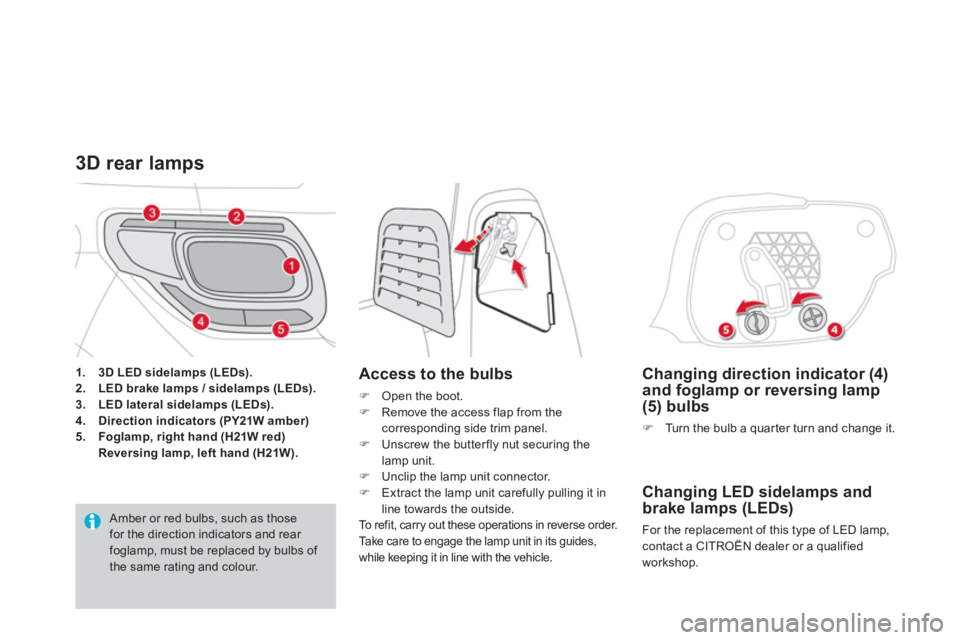
Changing direction indicator (4)and foglamp or reversing lamp(5) bulbs
�)Turn the bulb a quar ter turn and change it.
Changing LED sidelamps and
brake lamps (LEDs)
For the replacement of this type of LED lamp,contact a CITROËN dealer or a qualified
workshop.
3D rear lamps
Access to the bulbs
�)
Open the boot. �)
Remove the access flap from the corresponding side trim panel.
�)
Unscrew the butterfly nut securing thelamp unit.�)
Unclip the lamp unit connector.�)
Extract the lamp unit carefully pulling it in line towards the outside.
To r e f i t , c a r ry out these operations in reverse order.
Ta k e c a r e t o e ngage the lamp unit in its guides,
while keeping it in line with the vehicle.
1.3D LED sidelamps (LEDs).2.LED brake lamps / sidelamps (LEDs).3.LED lateral sidelamps (LEDs).4.Direction indicators (PY21W amber)
5.
Foglamp, right hand (H21W red)
Reversing lamp, left hand (H21W).
Amber or red bulbs, such as thosefor the direction indicators and rear foglamp, must be replaced by bulbs of the same rating and colour.